
Research Article
Ann Agric Crop Sci. 2023; 8(3): 1136.
Yield and Nutrient Uptake of Green Gram (Vigna radiata L.) and Weeds as Influenced by Different Integrated Weed Management Practices in Western Uttar Pradesh
Pooja Singh1*; Vivek1; Preeti Singh1; Akshay Ujjawal1; Mausmi Rastogi1; Sushmita1; Mandvi Srivastava2
1Department of Agronomy, Sardar Vallabhbhai Patel University of Agriculture & Technology, Meerut, Uttar Pradesh, India
2Department of Agronomy, Chandra Shekhar Azad University of Agriculture & Technology, Meerut, Uttar Pradesh, India
*Corresponding author: Pooja Singh Department of Agronomy, Sardar Vallabhbhai Patel University of Agriculture & Technology, Meerut, Uttar Pradesh, India. Email: poojasingh191098@gmail.com
Received: April 26, 2023 Accepted: May 31, 2023 Published: June 07, 2023
Abstract
The field experiment was conducted at Crop Research Centre of Sardar Vallabhbhai Patel University of Agriculture & Technology in Meerut (U.P.) during kharif 2021 to assess the performance of post-emergence application of Imazethapyr and Quizalofop-ethyl in combination with pre-emergence application of Pendimethalin on green gram (Vigna radiata L.). The experiment laid out in randomized block design with three replications and comprised of treatments Control (Weedy check) T1, Weed free T2, One hand weeding 20 DAS T3, Two hand weeding 20 and 40 DAS T4, Quizalofop-ethyl 50g a.i./ha Post-emergence (20 DAS) T5, Quizalofop-ethyl 50g a.i./ha Post-emergence (20 DAS) + one hand weeding 40 DAS T6, Imazethapyr 50g a.i./ha Post emergence (20 DAS) T7, Imazethapyr 50g a.i./ha 20 DAS + one hand weeding 40 DAS T8, Pendimethalin 1.0kg a.i./ha Pre emergence T9 and Pendimethalin 1.0kg a.i./ha Pre emergence + Imazethapyr 50g a.i./ha 20 DAS + one hand weeding 40 DAS T10. Treatments effects were evaluated in terms of weed dynamics growth and yield of green gram. The highest total NPK content and uptake by grain and straw found with weed free treatment followed by Pendimethalin 1.0kg a.i./ha Pre emergence + Imazethapyr 50g a.i./ha 20 DAS + one hand weeding 40 DAS was at par with Imazethapyr 50g a.i./ha 20 DAS + one hand weeding 40 DAS. Among the herbicides, the lowest total NPK content and uptake by weed was found with the application of Pendimethalin 1.0kg a.i./ha Pre emergence + Imazethapyr 50g a.i./ha 20 DAS + one hand weeding 40 DAS. The results revealed that treatment T2 (weed free) had the best financial return (Rs 91250 ha-1) and B:C ratio (2.72), while among the herbicides treatment T10 and T8 had the highest net financial return (Rs 92706 ha-1) and B:C ratio (3.14) respectively.
Keywords: Green gram; Herbicide; Weed dynamics; Productivity; Profitability
Introduction
One of the main pulse crops in India among pulses is green gram [Vigna radiata L.) Wilczek.] which grows in arid and semi-arid areas. It thrives in locations with low and unpredictable rainfall, light textured soils with limited water holding capacity, and is also drought-resistant. It is a short duration crop and works well in a variety of multiple and intercropping systems. It is cultivated in area about 4.5 million hectares and yields 2.64 million tones with a productivity 555kg ha-1 [1].
The main weeds in the test field were Echinochloa colonum (L.), Cynodon dactylon (L.), Eleusine indica (L.), Digitaria sanguinalis (L.), Trianthema portulacstrum (L.), Trianthema monogyna (L.), Celosia argentia (L.), Amaranthus viridis (L.), Parthenium hysterophorus (L.), and Cyperus rotundus (L.).
Weeds play a substantial role in the decline of green gram production. This can be ascribed to the fact that it is typically grown using residual soil moisture without any weed management at all. In green gram, weeds can result in yield losses of up to 80% [7]. Weeds compete with crops for natural and applied resources, resulting in a decrease in agricultural production in both quantity and quality.
According to a recent study [4], manual weeding followed by herbicides was the most effective at reducing weed density and biomass. According to [13], integrated weed management was the most cost-effective method. Application of Pendimethalin 1.0kg a.i./ha Pre emergence + Imazethapyr 50g a.i./ha 20 DAS + one-hand weeding 40 DAS resulted in higher yield, gave the highest net monetary returns, and B:C ratio, and was found to be the most efficient and cost-effective method for reducing weeds and increasing green gram yield.
Materials and Methods
The field experiment was carried out at CRC farm of the Sardar Vallabhbhai Patel University of Agriculture and Technology, Meerut (U.P.) located in Indo-Gangetic plains of Western Uttar Pradesh. During the crop growing season, the weekly mean maximum temperature ranged from 39.49°C to 31.83°C, while the weekly mean minimum temperature ranged from 21.71°C to 30.19°C. The area receives mean annual rainfall of 867mm. During the crop period, the average relative humidity ranged from 93.7% to 37.7%. The soil of experimental site was sandy loam in texture, low in available nitrogen and organic carbon, medium in available phosphorus and potassium and slightly alkaline in reaction. The predominant soil having pH 7.4, bulk density 1.49g/cm3, low organic carbon content (0.42%). The gross and net plot size were 5.0x3.6m2 and 4.0x1.8m2, respectively. A field research using four herbicides with and without hand weeding, weed-free conditions, and control (weedy check) was done in green gram to determine the optimal weed control technique. Three replications and a randomised block design were used for the experiment. Weedy check, Weed free, one hand weeding 20 DAS, two hand weeding 20 and 40 DAS, Quizalofop-ethyl 50g a.i./ha Post - emergence (20 DAS), Quizalofop-ethyl 50g a.i./ha Post - emergence (20 DAS) + one hand weeding 40 DAS, Imazethapyr 50g a.i./ha Post emergence (20 DAS), Imazethapyr 50g a.i./ha 20 DAS + one hand weeding 40 DAS, Pendimethalin 1.0kg a.i./ha Pre emergence and Pendimethalin 1.0kg a.i./ha Pre emergence + Imazethapyr 50g a.i./ha 20 DAS + one hand weeding 40 DAS were the ten weed management treatments used for the experimentation. Plant-to-plant distance was maintained ~10cm in a row spacing of 30cm. As per advice, 100kg/ha of Diammonium Phosphate (DAP) was applied during seed bed preparation. After pre-sowing irrigation, the field was prepared, and further irrigation was administered as needed to guarantee proper germination. Pendimethalin was applied as pre-emergence within 24 hours of sowing, whereas Imazethapyr was applied 20 Days After Sowing (DAS). Other practices were followed as per recommendation for this region. In order to collect data on weed population and dry weight in each plot (just prior to Imazethapyr application) at 25, 50 DAS and at harvest an iron square of 0.25m² (side 0.5m) through random sampling was utilised. For dry matter, weeds collected from 0.25m² areas were dried under the sun and then in an oven at 70°C for 72 h, weighed (g/m²). Economics of treatments was computed on the basis of prevailing market price of inputs and outputs under each treatment. Statistical analysis of the data was done as per the standard analysis of variance technique for the experimental designs following SPSS software based programme, and the treatment means were compared at P<0.05 level of probability using t-test and calculating CD values.
Results and Discussion
Influence of Herbicides on Weeds
Different integrated weed management practices-based treatments had a substantial impact on the density of total weeds. Among weed control treatments, the highest total weed density (17.6, 18.2 and 17.5m-2) was found under weedy check treatment, at 25, 50 DAS and at harvest, respectively.
Among all the treatments except weed free, the lowest total weed density was observed (6.4 m-2) in the treatment of Pendimethalin 1.0kg a.i./ha Pre emergence + Imazethapyr 50g a.i./ha 20 DAS + one hand weeding 40 DAS. At 50 DAS and at harvest the lowest total weed density (6.9m-2 & 6.6m-2) was observed with the application of Pendimethalin 1.0kg a.i./ha Pre emergence + Imazethapyr 50g a.i./ha 20 DAS + one hand weeding 40 DAS, which was found statistically at par with Imazethapyr 50g a.i./ha 20 DAS + one hand weeding 40 DAS (8.0 & 7.3m-2) at 50 DAS and at harvest, respectively
Total weed dry weight was affected significantly by various treatments involving integrated weed management practices. Among weed control treatments, significantly the highest total weed dry weight (7.5, 11.2 & 12.6 g m-2) was found in weedy check at 25, 50 DAS and at harvest. This was due to the fact that at later stage most of the weed growth ceased because of leaf senescence, and thereby resulted in reduction in dry matter accumulation of weeds. Higher infestation of weeds under weedy check was also reported by Patil et al., (2014) & Kumar et al., (2016).
Among the herbicides at 25 DAS the total dry weight observed (4.1g m-2) was lowest with the application of Pendimethalin 1.0kg a.i./ha Pre emergence + Imazethapyr 50g a.i./ha 20 DAS + one hand weeding 40 DAS than rest of the treatments. At 50 DAS total dry weight observed (5.9g m-2) was significantly lowest with the application of Pendimethalin 1.0kg a.i./ha Pre emergence + Imazethapyr 50g a.i./ha 20 DAS + one hand weeding 40 DAS, which was statistically at par with Imazethapyr 50g a.i./ha 20 DAS + one hand weeding 40 DAS (6.4g m-2). Significantly lower total dry weight at harvest (6.7g m-2) observed with the application of Pendimethalin 1.0kg a.i./ha Pre emergence + Imazethapyr 50g a.i./ha 20 DAS + one hand weeding 40 DAS was found at par with Imazethapyr 50g a.i./ha 20 DAS + one hand weeding 40 DAS (7.2g m-2) and significantly lower than the remaining treatments was also reported by Yadav et al., (2010) & Chhodavadia et al., (2013).
Weed Control Efficiency (WCE)
Weed control efficiency was affected significantly by various treatments involving integrated weed management practices. Among weed control treatments significantly the highest weed control efficiency (100.0 %) was found in weed free at harvest, respectively. Among the herbicides highest weed control efficiency (72.4%) with the application of Pendimethalin 1.0kg a.i./ha Pre emergence + Imazethapyr 50g a.i./ha 20 DAS + one hand weeding 40 DAS was at par with Imazethapyr 50g a.i./ha 20 DAS + one hand weeding 40 DAS (67.6%) at harvest, respectively. This result is in corroboration with the findings of Gupta et al. (2013).
Among the herbicides, the highest nitrogen content in green gram grain and straw was found with the application of Pendimethalin 1.0kg a.i./ha Pre emergence + Imazethapyr 50g a.i./ha 20 DAS + one hand weeding 40 DAS (3.96 & 0.74%) followed by Imazethapyr 50g a.i./ha 20 DAS + one hand weeding 40 DAS (3.93 & 0.71%).
Among the herbicides, the highest phosphorus content in green gram grain and straw were found with the application of Pendimethalin 1.0kg a.i./ha Pre emergence + Imazethapyr 50g a.i./ha 20 DAS + one hand weeding 40 DAS (0.35 & 0.24%), which were statistically at par with Imazethapyr 50g a.i./ha 20 DAS + one hand weeding 40 DAS (0.33 & 0.22%). The lowest potassium (0.39 & 1.10%) of green gram grain and straw were found in weedy check at harvest. The highest green gram grain and straw potassium content (0.56 & 1.37%) were observed in weed free treatment similar result was observed by Yadav et al. (2014).
Influence on Nutrient Uptake by Crop
Among the herbicides, the highest nitrogen uptake grain and straw (54.6 and 26.0kg ha-1) were found with the application of Pendimethalin 1.0kg a.i./ha Pre emergence + Imazethapyr 50g a.i./ha 20 DAS + one hand weeding 40 DAS followed by (48.6 & 23.9kg ha-1 respectively) with the application of Imazethapyr 50g a.i./ha 20 DAS + one hand weeding 40 DAS. The lowest nitrogen uptake in grain and straw recorded in control plot (15.8 and 9.1kg ha-1).
The highest phosphorus uptake in green gram grain and straw were found with the application of Pendimethalin 1.0kg a.i./ha Pre emergence + Imazethapyr 50g a.i./ha 20 DAS + one hand weeding 40 DAS (4.8 & 8.4%) followed by Imazethapyr 50g a.i./ha 20 DAS + one hand weeding 40 DAS (4.1 & 7.1%). The highest potassium uptake by grain and straw 7.5 and 47.2kg ha-1 respectively, were found with the application of Pendimethalin 1.0kg a.i./ha Pre emergence + Imazethapyr 50g a.i./ha 20 DAS + one hand weeding 40 DAS followed by (6.4 and 44.5kg ha-1) Imazethapyr 50g a.i./ha 20 DAS + one hand weeding 40 DAS.
Influence on Nutrient Content by Weeds
The nitrogen, phosphorus and potassium content in weed ranged from (1.45 to 1.75, 0.16 to 0.34 and 1.04 to 1.30 (%) under different treatments. The lowest nitrogen, phosphorus and potassium content 1.45, 0.16 & 1.04 (%) was observed in weed free, respectively because no weed were allowed to grow in this field Nagender et al. (2018) and Tiwari et al. (2018) also reported similar results.
Among the herbicides, the lowest total nitrogen content 1.47 (%) was found with the application of Pendimethalin 1.0kg a.i./ha Pre emergence + Imazethapyr 50g a.i./ha 20 DAS + one hand weeding 40 DAS, which was significantly lower than the remaining herbicide treatments. The lowest phosphorus content 0.21 (%) was found with the application of Pendimethalin 1.0kg a.i./ha Pre emergence + Imazethapyr 50g a.i./ha 20 DAS + one hand weeding 40 DAS, which was significantly lower than the remaining herbicide treatments. The lowest potassium content 1.11 (%) was found with the application of Pendimethalin 1.0kg a.i./ha Pre emergence + Imazethapyr 50g a.i./ha 20 DAS + one hand weeding 40 DAS, which was significantly lower than the remaining treatments. Jadhav (2013) and Osari et al. (2019) also reported similar results.
Influence on Nutrient Uptake by Weeds
The lowest nitrogen uptake (6.4kg ha-1) was found with the application of Pendimethalin 1.0kg a.i./ha Pre emergence + Imazethapyr 50g a.i./ha 20 DAS + one hand weeding 40 DAS, which was significantly lower than the remaining herbicide treatments. The lowest phosphorus (0.90kg ha-1) was found with the application of Pendimethalin 1.0kg a.i./ha Pre emergence + Imazethapyr 50g a.i./ha 20 DAS + one hand weeding 40 DAS, which was significantly lower than the remaining herbicide treatments. The lowest potassium uptake (4.8kg ha-1) was found with the application of Pendimethalin 1.0kg a.i./ha Pre emergence + Imazethapyr 50g a.i./ha 20 DAS + one hand weeding 40 DAS.
Crop Productivity
Grain yield was affected significantly by various treatments involving integrated weed management practices. Among weed control treatments, the lowest grain yield (5.2 q ha-1) was found in weedy check. The highest grain yield (14.1 q ha-1) was found in weed free.
Among the herbicides the significantly highest grain yield (13.8 q ha-1) was recorded with the application of Pendimethalin 1.0kg a.i./ha Pre emergence + Imazethapyr 50g a.i./ha 20 DAS + one hand weeding 40 DAS followed by Imazethapyr 50g a.i./ha 20 DAS + one hand weeding 40 DAS. Pendimethalin 1.0kg a.i./ha Pre emergence + Imazethapyr 50g a.i./ha 20 DAS + one hand weeding 40 DAS recorded (165.3 %) higher grain yield over weedy check.
Biological yield was affected significantly by various treatments involving integrated weed management practices. Among weed control treatments, the lowest biological yield (23.7 q ha-1) found in weedy check. The highest biological yield (49.6 q ha-1) was found in weed free. Similar findings were reported by Singh (2014).
Among the herbicides, the highest biological yield (49.0 q ha-1) was recorded with the application of Pendimethalin 1.0kg a.i./ha Pre emergence + Imazethapyr 50g a.i./ha 20 DAS + one hand weeding 40 DAS, which was statistically at par with Imazethapyr 50g a.i./ha 20 DAS + one hand weeding 40 DAS (46.1 q ha-1). Pendimethalin 1.0kg a.i./ha Pre emergence + Imazethapyr 50g a.i./ha 20 DAS + one hand weeding 40 DAS (106.7%) higher biological yield over weedy check.
Treatments
Total weed density ( m-2)
25 DAS
50 DAS
At harvest
T1
Control (Weedy check)
17.6(309.3)
18.2(330.1)
17.5(307.0)
T2
Weed free
1.0(0.0)
1.0(0.0)
1.0(0.0)
T3
One hand weeding 20 DAS
8.6(74.2)
9.5(90.1)
9.1(81.7)
T4
Two hand weeding 20 and 40 DAS
8.5(72.8)
8.7(75.5)
8.1(63.9)
T5
Quizalofop-ethyl 50g a.i./ha Post - emergence (20 DAS)
10.0(98.3)
10.8(116.7)
10.4(106.4)
T6
Quizalofop-ethyl 50g a.i./ha Post - emergence (20 DAS) + one hand weeding 40 DAS
9.8(96.7)
8.9(78.5)
8.3(68.0)
T7
Imazethapyr 50g a.i./ha Post emergence (20 DAS)
9.5(90.0)
10.4(107.9)
9.8(94.2)
T8
Imazethapyr 50g a.i./ha 20 DAS + one hand weeding 40 DAS
9.4(88.3)
8.0(62.7)
7.3(53.0)
T9
Pendimethalin 1.0kg a.i./ha Pre emergence
8.8(75.6)
10.1(101.0)
9.3(86.3)
T10
Pendimethalin 1.0kg a.i./ha Pre emergence + Imazethapyr 50g a.i./ha 20 DAS + one hand weeding 40 DAS
6.4(40.2)
6.9(46.8)
6.6(42.8)
SEm+
0.30
0.34
0.32
C.D.(P=0.05)
0.88
0.98
0.92
Table 1: Effect of integrated weed management practices on total weeds density (m-2) in green gram at different stages.
Treatments
Total weed dry weight (g m-2)
25 DAS
50 DAS
At harvest
T1
Control (Weedy check)
7.5(55.7)
11.2(125.5)
12.6(156.9)
T2
Weed free
1.0(0.0)
1.0(0.0)
1.0(0.0)
T3
One hand weeding 20 DAS
5.4(28.7)
7.8(59.5)
8.4(70.1)
T4
Two hand weeding 20 and 40 DAS
5.3(27.3)
6.6(42.2)
7.4(53.2)
T5
Quizalofop-ethyl 50g a.i./ha Post - emergence (20 DAS)
5.8(32.5)
8.2(67.0)
8.9(79.1)
T6
Quizalofop-ethyl 50g a.i./ha Post - emergence (20 DAS) + one hand weeding 40 DAS
5.6(31.2)
6.8(44.6)
7.5(55.6)
T7
Imazethapyr 50g a.i./ha Post emergence (20 DAS)
5.7(31.5)
8.2(65.5)
8.8(76.8)
T8
Imazethapyr 50g a.i./ha 20 DAS + one hand weeding 40 DAS
5.5(30.3)
6.4(39.4)
7.2(50.9)
T9
Pendimethalin 1.0kg a.i./ha Pre emergence
5.6(30.5)
7.9(61.4)
8.6(72.5)
T10
Pendimethalin 1.0kg a.i./ha Pre emergence + Imazethapyr 50g a.i./ha 20 DAS + one hand weeding 40 DAS
4.1(15.7)
5.9(34.2)
6.7(43.3)
SEm+
0.18
0.26
0.28
C.D.(P=0.05)
0.52
0.74
0.82
Table 2: Effect of integrated weed management practices on total weeds dry weight (g m-2) at different stages.
Treatments
Weed control efficiency (%)
T1
Control (Weedy check)
0.0
T2
Weed free
100.0
T3
One hand weeding 20 DAS
55.3
T4
Two hand weeding 20 and 40 DAS
66.1
T5
Quizalofop-ethyl 50g a.i./ha Post - emergence
(20 DAS)49.6
T6
Quizalofop-ethyl 50g a.i./ha Post - emergence (20 DAS) + one hand weeding 40 DAS
64.6
T7
Imazethapyr 50g a.i./ha Post emergence (20 DAS)
51.1
T8
Imazethapyr 50g a.i./ha 20 DAS + one hand weeding 40 DAS
67.6
T9
Pendimethalin 1.0kg a.i./ha Pre emergence
53.8
T10
Pendimethalin 1.0kg a.i./ha Pre emergence + Imazethapyr 50g a.i./ha 20 DAS + one hand weeding 40 DAS
72.4
SEm+
2.3
C.D.(P=0.05)
6.7
Table 3: Effect of weed management practices on weed control efficiency (%) at harvest.
Symbol
Treatment
N content (%)
P content (%)
K content (%)
Grain
Straw
Grains
Straw
Grains
Straw
T1
Control (Weedy check)
3.04
0.49
0.20
0.10
0.39
1.10
T2
Weed free
4.00
0.75
0.36
0.24
0.56
1.37
T3
One hand weeding 20 DAS
3.87
0.66
0.29
0.18
0.49
1.23
T4
Two hand weeding 20 and 40 DAS
3.91
0.70
0.31
0.21
0.51
1.28
T5
Quizalofop-ethyl 50g a.i./ha Post - emergence (20 DAS)
3.27
0.55
0.22
0.11
0.40
1.11
T6
Quizalofop-ethyl 50g a.i./ha Post - emergence (20 DAS) + one hand weeding 40 DAS
3.89
0.68
0.30
0.20
0.50
1.25
T7
Imazethapyr 50g a.i./ha Post emergence (20 DAS)
3.66
0.58
0.24
0.13
0.43
1.13
T8
Imazethapyr 50g a.i./ha 20 DAS + one hand weeding 40 DAS
3.92
0.71
0.33
0.22
0.52
1.32
T9
Pendimethalin 1.0kg a.i./ha Pre emergence
3.73
0.62
0.26
0.14
0.47
1.17
T10
Pendimethalin 1.0kg a.i./ha Pre emergence + Imazethapyr 50g a.i./ha 20 DAS + one hand weeding 40 DAS
3.96
0.74
0.35
0.24
0.54
1.34
SEm (±)
0.13
0.02
0.01
0.01
0.02
0.04
C.D. (P=0.05)
0.39
0.07
0.03
0.02
0.05
0.13
Table 4: Effect of Integrated weed management practices on nitrogen, phosphorus and potassium content (%) in grains and straw of green gram.
Symbol
Treatment
N uptake
(kg ha-1)P uptake
(kg ha-1)K uptake
(kg ha-1)Grain
Straw
Grain
Straw
Grain
Straw
T1
Control (Weedy check)
15.8
9.1
1.0
1.9
2.0
20.4
T2
Weed free
56.4
26.6
5.1
8.5
7.9
48.6
T3
One hand weeding 20 DAS
36.8
20.3
2.8
5.5
4.7
37.9
T4
Two hand weeding 20 and 40 DAS
45.7
22.5
3.6
6.7
6.0
41.1
T5
Quizalofop-ethyl 50g a.i./ha Post - emergence (20 DAS)
27.8
15.7
1.9
3.1
3.4
31.6
T6
Quizalofop-ethyl 50g a.i./ha Post - emergence (20 DAS) + one hand weeding 40 DAS
42.0
21.7
3.2
6.4
5.4
39.9
T7
Imazethapyr 50g a.i./ha Post emergence (20 DAS)
33.3
17.3
2.2
3.9
3.9
33.8
T8
Imazethapyr 50g a.i./ha 20 DAS + one hand weeding 40 DAS
48.6
23.9
4.1
7.1
6.4
44.5
T9
Pendimethalin 1.0kg a.i./ha Pre emergence
35.1
19.0
2.4
4.3
4.4
35.8
T10
Pendimethalin 1.0kg a.i./ha Pre emergence + Imazethapyr 50g a.i./ha 20 DAS + one hand weeding 40 DAS
54.6
26.0
4.8
8.4
7.5
47.2
SEm±
1.5
0.7
0.12
0.22
0.20
1.4
CD (P= 0.05)
4.4
2.2
0.36
0.64
0.58
4.1
Table 5: Nitrogen, phosphorus and potassium uptake (kg ha-1) by green gram as influenced by integrated weed management treatments.
Symbol
Treatments
Nutrient content (%)
Nitrogen
Phosphorus
Potassium
T1
Control (Weedy check)
1.75
0.34
1.30
T2
Weed free
1.45
0.16
1.04
T3
One hand weeding 20 DAS
1.60
0.27
1.22
T4
Two hand weeding 20 and 40 DAS
1.51
0.23
1.17
T5
Quizalofop-ethyl 50g a.i./ha Post - emergence (20 DAS)
1.55
0.32
1.27
T6
Quizalofop-ethyl 50g a.i./ha Post - emergence (20 DAS) + one hand weeding 40 DAS
1.58
0.26
1.20
T7
Imazethapyr 50g a.i./ha Post emergence (20 DAS)
1.64
0.30
1.25
T8
Imazethapyr 50g a.i./ha 20 DAS + one hand weeding 40 DAS
1.61
0.22
1.14
T9
Pendimethalin 1.0kg a.i./ha Pre emergence
1.62
0.29
1.23
T10
Pendimethalin 1.0kg a.i./ha Pre emergence + Imazethapyr 50g a.i./ha 20 DAS + one hand weeding 40 DAS
1.47
0.21
1.11
SEm (±)
0.03
0.01
0.04
C.D. (P=0.05)
0.09
0.03
0.12
Table 6: Effect of Integrated weed management practices on nutrient content (%) of weeds at harvest.
Symbol
Treatments
Nutrient uptake (kg ha-1)
Nitrogen
Phosphorus
Potassium
T1
Control (Weedy check)
27.5
5.3
20.4
T2
Weed free
0.0
0.0
0.0
T3
One hand weeding 20 DAS
11.2
1.9
8.6
T4
Two hand weeding 20 and 40 DAS
8.0
1.2
6.2
T5
Quizalofop-ethyl 50g a.i./ha Post - emergence (20 DAS)
12.2
2.5
10.0
T6
Quizalofop-ethyl 50g a.i./ha Post - emergence (20 DAS) + one hand weeding 40 DAS
8.8
1.4
6.7
T7
Imazethapyr 50g a.i./ha Post emergence (20 DAS)
12.6
2.3
9.6
T8
Imazethapyr 50g a.i./ha 20 DAS + one hand weeding 40 DAS
8.1
1.1
5.8
T9
Pendimethalin 1.0kg a.i./ha Pre emergence
11.7
2.1
8.9
T10
Pendimethalin 1.0kg a.i./ha Pre emergence + Imazethapyr 50g a.i./ha 20 DAS + one hand weeding 40 DAS
6.4
0.9
4.8
SEm (±)
0.3
0.1
0.5
C.D. (P=0.05)
0.9
0.3
1.3
Table 7: Effect of Integrated weed management practices on nutrient uptake (kg ha-1) of weeds at harvest.
Treatments
Yield (q ha-1)
Harvest index (%)
Grains
Straw
Biological
T1
Control (Weedy check)
5.2
18.5
23.7
21.9
T2
Weed free
14.1
35.5
49.6
28.4
T3
One hand weeding 20 DAS
9.5
30.8
40.3
23.6
T4
Two hand weeding 20 and 40 DAS
11.7
32.1
43.8
26.7
T5
Quizalofop-ethyl 50g a.i./ha Post - emergence (20 DAS)
8.5
28.5
37.0
23.0
T6
Quizalofop-ethyl 50g a.i./ha Post - emergence (20 DAS) + one hand weeding 40 DAS
10.8
31.9
42.7
25.3
T7
Imazethapyr 50g a.i./ha Post emergence (20 DAS)
9.1
29.9
39.0
23.3
T8
Imazethapyr 50g a.i./ha 20 DAS + one hand weeding 40 DAS
12.4
33.7
46.1
26.9
T9
Pendimethalin 1.0kg a.i./ha Pre emergence
9.4
30.6
40.0
23.5
T10
Pendimethalin 1.0kg a.i./ha Pre emergence + Imazethapyr 50g a.i./ha 20 DAS + one hand weeding 40 DAS
13.8
35.2
49.0
28.1
SEm (±)
0.4
1.1
1.5
0.9
C.D. (P=0.05)
1.1
3.3
4.4
2.6
Table 8: Effect of Integrated weed management practices on performance of green gram (Vigna radiata L.) and associated weeds.
Symbol
Treatments
Cost of cultivation (Rs ha-1)
Gross return
(Rs ha-1)Net return
(Rs ha-1)B: C ratio
T1
Control (Weedy check)
24770
46790
22020
0.89
T2
Weed free
33570
124820
91250
2.72
T3
One hand weeding 20 DAS
28070
85062
56992
2.03
T4
Two hand weeding 20 and 40 DAS
31370
103944
72574
2.31
T5
Quizalofop-ethyl 50g a.i./ha Post - emergence (20 DAS)
26624
76240
49616
1.86
T6
Quizalofop-ethyl 50g a.i./ha Post - emergence (20 DAS) + one hand weeding 40 DAS
29704
96266
66562
2.24
T7
Imazethapyr 50g a.i./ha Post emergence (20 DAS)
25840
81536
55696
2.16
T8
Imazethapyr 50g a.i./ha 20 DAS + one hand weeding 40 DAS
28920
110118
81198
2.81
T9
Pendimethalin 1.0kg a.i./ha Pre emergence
26244
84184
57940
2.21
T10
Pendimethalin 1.0kg a.i./ha Pre emergence + Imazethapyr 50g a.i./ha 20 DAS + one hand weeding 40 DAS
29522
122228
92706
3.14
SEm (±)
-
2197
1156
0.08
C.D. (P=0.05)
-
6275
3302
0.22
Table 9: Laboratory values at hospital admission.
Harvest index was affected significantly by various treatments involving integrated weed management practices. Among weed control treatments, the lowest harvest index (21.9%) was found in weedy check, while the highest harvest index (28.4%) in weed free. Among the herbicides the highest harvest index (28.1%) recorded with the application of Pendimethalin 1.0kg a.i./ha Pre emergence + Imazethapyr 50g a.i./ ha 20 DAS + one hand weeding 40 DAS, which was at par with Imazethapyr 50g a.i./ha 20 DAS + one hand weeding 40 DAS. Pendimethalin 1.0kg a.i./ha Pre emergence + Imazethapyr 50g a.i./ha 20 DAS + one hand weeding 40 DAS recorded (28.3%) higher harvest index over weedy check. Similar findings were reported by Nagender et al. (2018).
Economics
Cost of cultivation was affected by various treatments involving integrated weed management practices. Among weed control treatments, the lowest cost of cultivation (Rs. 24770 ha-1) found in weedy check, which was lower than the remaining treatments. The highest cost of cultivation (Rs. 33570 ha-1) was found in weed free treatment, which was higher than other treatments. Among the herbicides, the highest cost of cultivation (Rs. 29522 ha-1) was recorded with the application of Pendimethalin 1.0kg a.i./ha Pre emergence + Imazethapyr 50g a.i./ha 20 DAS + one hand weeding 40 DAS, followed by Imazethapyr 50g a.i./ha 20 DAS + one hand weeding 40 DAS (Rs. 28920 ha-1). Singh (2011) and Gelot et al. (2016) also reported similar results
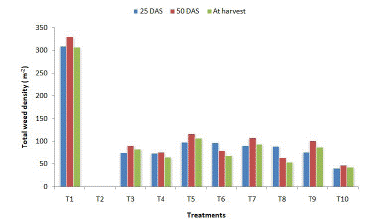
Figure 1: Effect of weed management practices on total weeds density (m-2) in green gram at different stages.
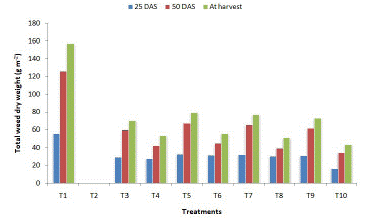
Figure 2: Effect of weed management practices on total weeds dry weight (g m-2) at different stages.
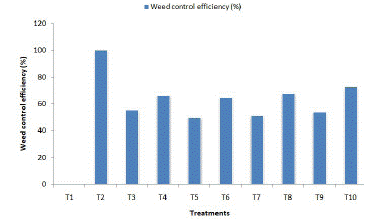
Figure 3: Effect of weed management practices on weed control efficiency (%) at harvest Influence on nutrient content by crop.
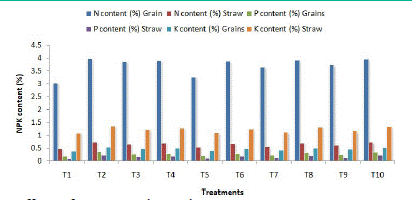
Figure 4: Effect of Integrated weed management practices on nitrogen, phosphorus and potassium content (%) in grains and straw of green gram.
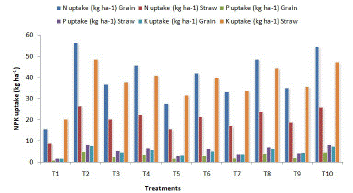
Figure 5: Effect of Integrated weed management practices on nitrogen, phosphorus and potassium uptake (kg ha-1) in grains and straw of green gram.
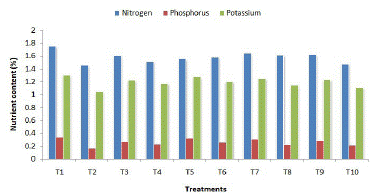
Figure 6: Effect of Integrated weed management practices on nutrient content (%) of weeds at harvest.
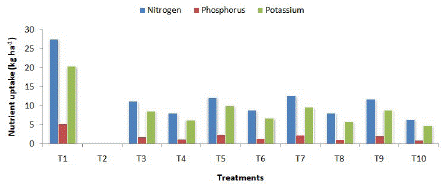
Figure 7: Effect of Integrated weed management practices on nutrient uptake (kg ha-1) of weeds at harvest.
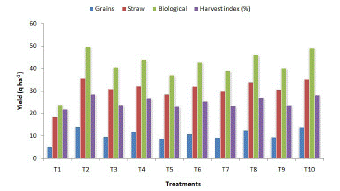
Figure 8: Effect of Integrated weed management practices on performance of green gram (Vigna radiate L.) and associated weeds.
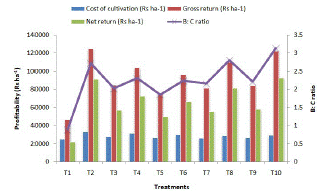
Figure 9: Economics of green gram as affected by integrated weed management practices.
Gross return was affected significantly by various treatments involving integrated weed management practices. Among weed control treatments, the lowest gross return (Rs. 46790 ha-1) was found in weedy check, which was significantly lower than the remaining treatments.
The highest gross return (Rs 124820 ha-1) was found in weed free treatment, which was higher than other treatments. Among the herbicidal treatments, the highest gross return (Rs 122228 ha-1) was recorded with the application of Pendimethalin 1.0kg a.i./ha Pre emergence + Imazethapyr 50g a.i./ha 20 DAS + one hand weeding 40 DAS followed by Imazethapyr 50g a.i./ha 20 DAS + one hand weeding 40 DAS (Rs 110118 ha-1). Pendimethalin 1.0kg a.i./ha Pre emergence + Imazethapyr 50g a.i./ha 20 DAS + one hand weeding 40 DAS was recorded (161.2%) higher gross return over weedy check.
Net return was affected significantly by various treatments involving integrated weed management practices. Among weed control treatments, the lowest net return (Rs 22020 ha-1) was found in weedy check and significantly lower than the remaining treatments, while the highest net return Rs 91250 ha-1) was found in weed free treatment and significantly higher than other treatments. Among the herbicides, the highest net return (Rs 92706 ha-1) was recorded with the application of Pendimethalin 1.0kg a.i./ha Pre emergence + Imazethapyr 50g a.i./ha 20 DAS + one hand weeding 40 DAS followed by Imazethapyr 50g a.i./ha 20 DAS + one hand weeding 40 DAS. Pendimethalin 1.0kg a.i./ha Pre emergence + Imazethapyr 50g a.i./ha 20 DAS + one hand weeding 40 DAS recorded (321.0%) higher net return over weedy check. These findings are in close agreement with the results of Singh (2011).
B: C ratio was affected significantly by various treatments involving integrated weed management practices. Among weed control treatments, the lowest B: C ratio (0.89) was found in weedy check, which was significantly lower than the remaining treatments while the highest B: C ratio (2.72) was recorded in weed free treatment.
Among the herbicides, the highest B: C ratio was recorded with the application of Pendimethalin 1.0kg a.i./ha Pre emergence + Imazethapyr 50g a.i./ha 20 DAS + one hand weeding 40 DAS (3.14) followed by Imazethapyr 50g a.i./ha 20 DAS + one hand weeding 40 DAS (2.81). Pendimethalin 1.0kg a.i./ha Pre emergence + Imazethapyr 50g a.i./ha 20 DAS + one hand weeding 40 DAS was recorded (252.8%) higher B: C ratio over weedy check. Osari et al. (2019) also reported similar results.
Conclusion
On the basis of two year study result outcome from experimental data showed that highest yield of green gram and nutrient content and uptake was noticed with weed free, which was found statistically at par with the application of Pendimethalin 1.0kg a.i./ha Pre emergence + Imazethapyr 50g a.i./ha 20 DAS + one hand weeding 40 DAS and Imazethapyr 50g a.i./ha 20 DAS + one hand weeding 40 DAS. Lowest nutrient content and uptake in weeds was noticed with Pendimethalin 1.0kg a.i./ha Pre emergence + Imazethapyr 50g a.i./ha 20 DAS + one hand weeding 40 DAS. Among integrated weed management treatments Pendimethalin 1.0kg a.i./ha Pre emergence + Imazethapyr 50g a.i./ha 20 DAS + one hand weeding 40 DAS was found excellent in gross return, net return, and B: C ratio which was at par with Imazethapyr 50g a.i./ha 20 DAS + one hand weeding 40 DAS. Thus, it can be concluded that the application of Pendimethalin 1.0kg a.i./ha Pre emergence + Imazethapyr 50g a.i./ha 20 DAS + one hand weeding 40 DAS is better for higher productivity and profitability of green gram crop.
Author Statements
Acknowledgement
The author thanks the, Department of Agronomy, College of Agriculture, Sardar Vallabhbhai Patel University of Agriculture & Technology, Meerut (U.P.) for providing facilities for successful completion of the research works.
References
- Anonymous, 2020-21. Ministry of Agriculture Department of agriculture and cooperation. Ministry of agriculture Govt. of India New Delhi.
- Chaudhari VD, Desai LJ, Chaudhari SN, Chaudhari PR. Effect of weed management on weeds, growth and yield of summer greengram (Vigna radiata L.). The Bioscan. 2016; 11: 531-534.
- Chhodavadia SK, Mathukiya RK, Dobariya VK. Pre and post-emergence herbicides for integrated weed management in summer greengram. Indian Journal of Weed Science. 2013; 45: 137-139.
- Dixit A, Varshney JG. Bioefficacy of imazethapyr against weeds in soybean. Annual Report 2006-07. National Research Centre for Weed Science, Jabalpur. 2007; 7-8.
- Gelot DG, Patel DM, Patel KM, Patel IM, Patel FN, et al. Effect of integrated weed management on weed control and yield of summer greengram (Vigna radiate L). International Journal of Chemical Studies. 2016; 6: 324-327.
- Gupta V, Singh M, Kumar A, Sharma BC, Kher D. Influence of weed management practices on weed dynamics and yield of urdbean (Vigna mungo) under rainfed conditions of Jammu. Indian Journal of Agronomy. 2013; 58: 220-225.
- Gurjar MS, Kushwah SS, Jain VK, Kushwah HS. Effect of different herbicides and cultural practices on growth, yield and economics of soybean [Glycine max (L.) Merrill.]. Agricultural Science Digest. 2001; 21: 13-16.
- Jadhav VT. Yield and economics of soybean under integrated weed management practices.Indian Journal of Weed Science. 2013; 45: 39-41.
- Kumar N, Hazra KK, Nadarajan N. Efficacy of post emergence application of imazethapyr in summer mungbean (Vignaradiata L.).Legume Research. 2016; 39: 96-100.
- Nagender T, Srinivas A, Rani LP, Narender J. Effect of different herbicides on growth and yield of greengram (Vignaradiata L.). Environment and ecology. 2018; 354D: 3559-3562.
- Osari S, Marskole J, Jatav KS, Bhadauria SS. Efficacy of herbicides controlling on weed flora and productivity of greengram.International journal of chemical studies. 2019; SP6: 396-400.
- Patil MR, Chaudhari PM, Bodake PS, Patil SB, Girase PP. Effect of post emergence herbicides on weed management and seed yield of soybean in vertisols: 152. Biennial conference of Indian society of weed science on “Emerging challenges in weed management”. Directorate of Weed Science Research, Jabalpur. 2014.
- Savu RM, Choubey NK, Tiwari N. Chemical weed control in groundnut (Arachis hypogaea L.) under vertisols of Chhatisgarh plains. Journal of Inter academician. 2006; 10: 156-159.
- Sheoran P, Singh S, Sardana V, Bawa SS. Studies on critical period of crop-weed competition in green gram in Kandi region of Punjab. Indian Journal of Dryland Agriculture Research and Development. 2008; 23: 19-22.
- Singh G. Weed management in Summer and kharif season blackgram [Vignamungo (L.) Hepper. Indian Journal of Weed Science. 2011; 43: 77-80.
- Singh NK, Jat RK, Singh J, Choubey VK. Execution importance, herbicide application in soybean in raised bed system: 193. Biennial conference of Indian society of weed science on “Emerging challenges in weed management”. Directorate of weed science research, Jabalpur. 2014.
- Tiwari VK, Yadav RS, Mahajan R, Namdev B, Kumar S. Effect of weed management practices on yield attribution of urdbean under late sown. Journal of pharmacognosy and phytochemistry. 2018; 7: 742-746.
- Yadav RB, Vivek Singh R, Tomar SS. Integrated weed management in mungbean (Vigna radiates L.). Abstract presented on Biennial Conference of Indian Society of Weed Science on “Recent Advances in Weed Science Research – 2010”. February 25-26, 2010, Indira Gandhi Krishi Vishwavidyalaya, Raipur (Chhattisgarh). 2010; 97.